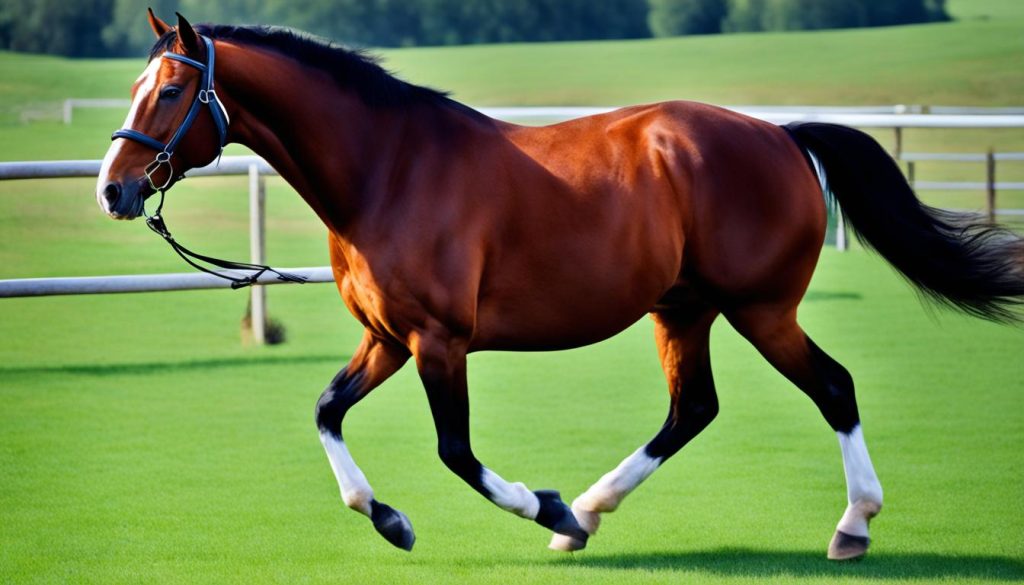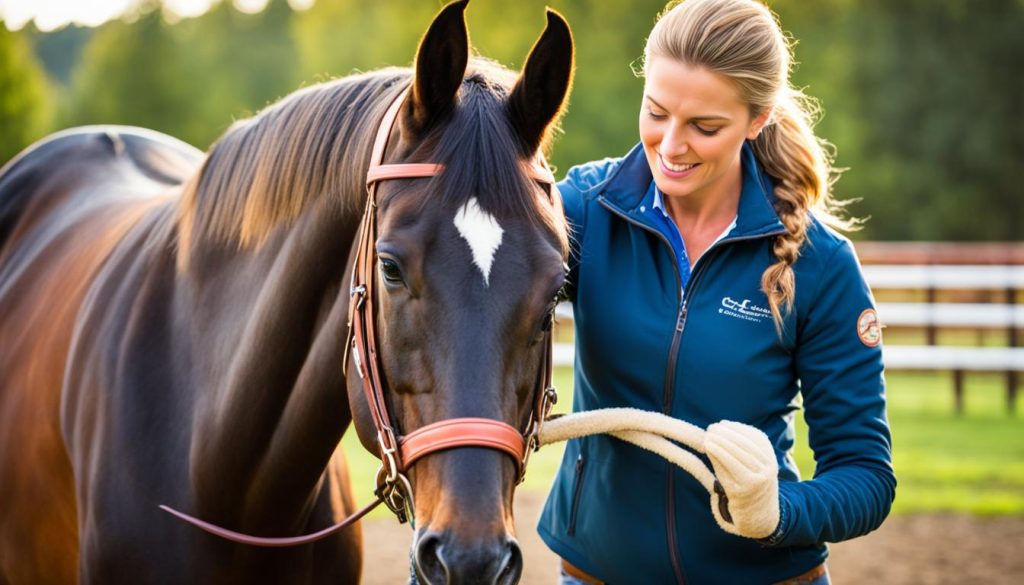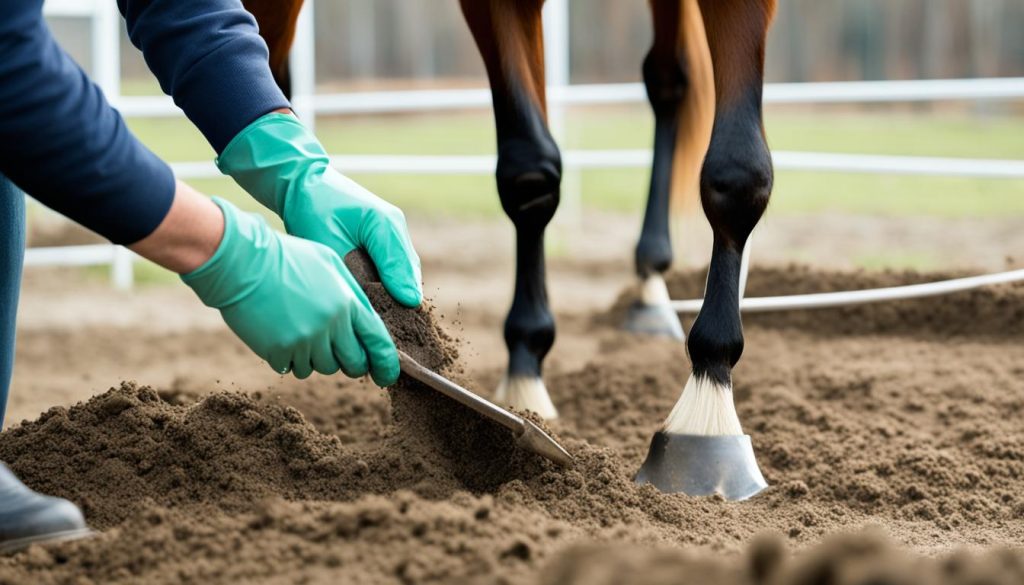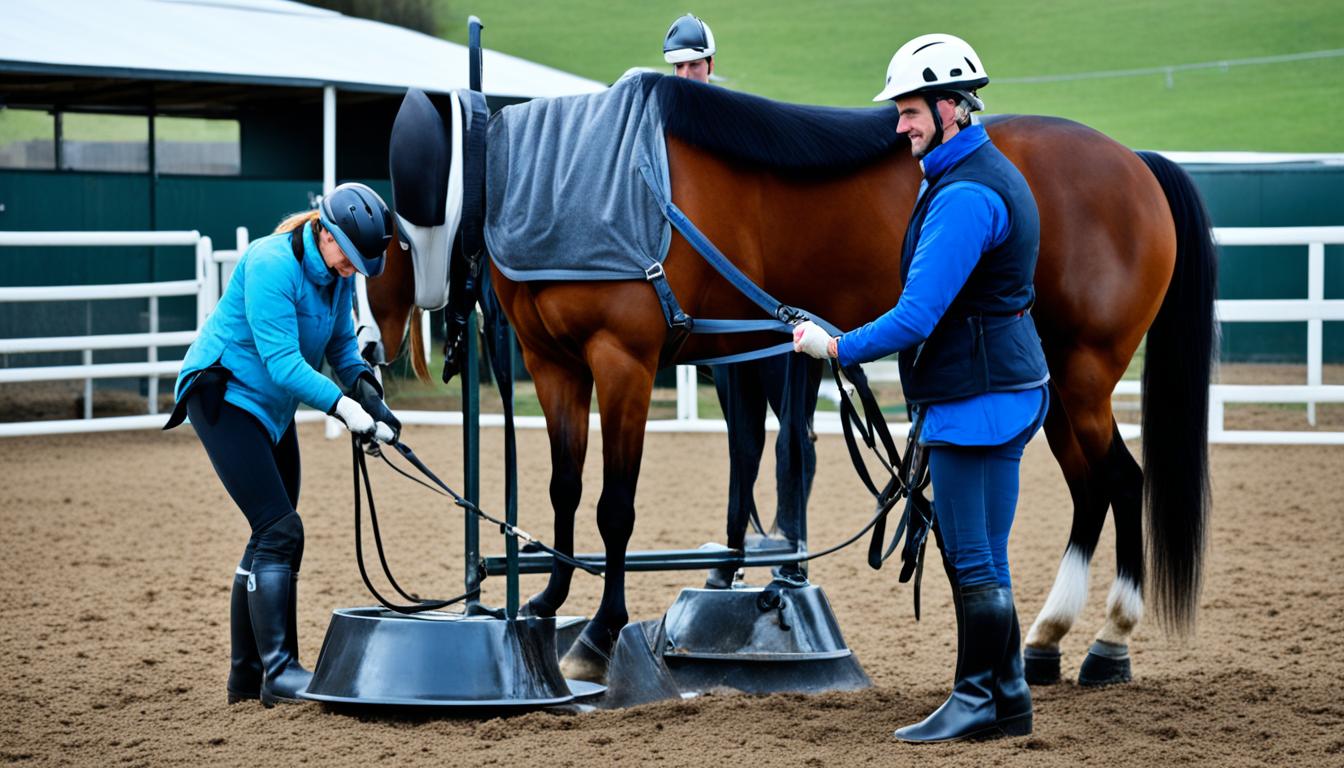Did you know that horses have a natural “flight or fight” response to perceived danger?
Horses are incredible animals that require careful handling and understanding of their behavior to ensure your safety and theirs. Whether you’re an experienced equestrian or a beginner, it’s vital to practice proper horse safety techniques to prevent accidents and maintain a harmonious relationship with these majestic creatures.
Key Takeaways:
- Noelle Floyd recommends learning about equine safety guidelines
- Always approach and handle horses confidently and calmly
- Proper haltering, knowing where to stand, and safe leading practices are essential
- Understanding horse behavior can help prevent accidents and ensure a safe working environment
- Seek help from experienced professionals if needed
Understanding Your Horse’s Behavior
Horses, being prey animals, have highly sensitive senses that play a significant role in their behavior. They respond to various stimuli in their environment like movements, smells, sounds, and sights. It is important for horse handlers and caretakers to develop an understanding of their horse’s behavior to ensure safety and well-being. Recognizing their body language and instinctual responses is essential in establishing a positive and secure environment.
“Horses are incredibly perceptive creatures. They have a natural instinct to flee or fight when they sense danger. By understanding their behavior, we can prevent accidents and foster mutual trust and respect.” – Jane Reynolds, Equine Behavior Expert
There are several visual and behavioral cues that can indicate a horse’s state of mind. Signs such as pinning back ears, arching the neck, or tucking the hind end can be indications of potential aggression or unease. By being aware of these behaviors, horse handlers can anticipate the horse’s reactions and take necessary precautions to ensure safety.
Visual Cues:
- Ears: Pinned-back or flattened ears often indicate aggression or annoyance.
- Body Posture: An arched neck or a lowered head can signify tension or discomfort.
- Tail Movements: Swishing or rapid tail movements may indicate irritation or agitation.
Behavioral Cues:
- Bucking: A sudden, forceful kick or a series of jumps may suggest excitement or defiance.
- Biting or Nipping: Aggressive or playful behavior that can lead to injury if not addressed.
- Kicking: A strong backward kick usually signifies frustration or a warning.
By observing and understanding these cues, horse handlers can respond appropriately and take necessary safety measures. Approaching a horse cautiously, maintaining a calm demeanor, and avoiding sudden movements are crucial in establishing trust and confidence with the animal. Patience and consistent positive reinforcement contribute to an overall safe and harmonious relationship between horse and handler.
It is important to note that each horse is unique, and their behavior can vary based on factors such as previous experiences, age, and training. Regular interaction and observation of individual horses will facilitate a deeper understanding of their behavior and enable horse handlers to tailor their approach accordingly.
“Understanding your horse’s behavior not only ensures safety but also enhances the bond between horse and handler. By communicating effectively and respecting their natural instincts, we can build a relationship based on trust and mutual understanding.” – Dr. Emily Myers, Equine Veterinarian
| Behavior | Meaning |
|---|---|
| Pinned-back Ears | Potential aggression or annoyance |
| Arched Neck | Tension or discomfort |
| Tail Swishing | Sign of irritation or agitation |
| Bucking | Excitement or defiance |
| Biting or Nipping | Aggression or playfulness |
| Kicking | Frustration or warning |

Proper Haltering Techniques
Proper haltering is essential for ensuring the safety of your horse. It is important to use a halter and lead rope that are in good condition and fit properly. The halter should have a nose piece that lays across the bridge of the nose comfortably, without being too tight. A well-fitted halter allows for better control and reduces the risk of injury to your horse.
When haltering your horse, approach them slowly and confidently, speaking to them in a soothing tone to reassure them. This helps to foster trust and cooperation. Take the time to slide the halter over your horse’s muzzle gently, making sure it is properly positioned. Once the halter is in place, fasten it securely, ensuring that it is snug but not overly tight.
If you are using a rope halter, it is important to tie it correctly for a secure fit. This involves knowing the proper tying technique and ensuring that the knot is secure. Incorrectly tied rope halters can easily come undone, putting both you and your horse at risk.
Pay close attention to the placement of the halter on your horse’s head. Avoid placing it too close to their eyes or too far back on their face. This can cause discomfort and potentially spook your horse. It is also essential to regularly check the condition of the halter and lead rope for any signs of wear and tear. Replace them as needed to maintain safety.
By following these proper haltering techniques, you can ensure the safety and well-being of your horse during handling and activity.
Where to Stand When Handling a Horse
Knowing where to stand when handling a horse is essential for both your safety and the horse’s well-being. Proper positioning allows you to maintain control and avoid unnecessary risks. Follow these stable safety protocols and riding safety rules for horses to ensure a safe and productive experience with your equine companion.
First and foremost, never stand directly in front of or behind a horse. These areas are blind spots for them, and sudden movements can startle or spook them, potentially leading to accidents. Instead, position yourself to the left side of the horse, between the head and shoulder, at the throat latch. This provides better control and visibility, allowing you to anticipate and respond to any changes in the horse’s behavior.
When standing next to the horse, stay close to their body. This position minimizes the risk of getting kicked and allows for better communication. Point your feet towards the horse’s neck or shoulder, which not only helps maintain balance but also enhances your readiness to respond if the horse becomes tense or frightened.
Remember to maintain eye contact with the horse. By doing so, you build trust and establish a connection, reassuring the horse that you are there to guide and protect them. This simple yet powerful gesture goes a long way in creating a calm and cooperative environment.
Integrating these stable safety protocols and riding safety rules for horses into your horse handling routine will cultivate a relationship built on trust and mutual respect. By positioning yourself strategically and being attentive to your horse’s needs, you can ensure a safer and more enjoyable experience for both of you.

| Stable Safety Protocols | Riding Safety Rules for Horses |
|---|---|
| 1. Position yourself to the left of the horse, between the head and shoulder, at the throat latch. | 1. Wear appropriate safety gear, such as a properly fitted helmet, gloves, and sturdy footwear. |
| 2. Stand close to the horse’s body, pointing your feet towards the neck or shoulder. | 2. Always warm up your horse before riding to prevent injuries and promote optimal performance. |
| 3. Maintain eye contact and establish a connection with the horse. | 3. Follow the established trail or path while riding and avoid dangerous terrain. |
| 4. Be aware of the horse’s behavior and respond promptly to signs of tension or fear. | 4. Observe proper traffic rules and signals when riding on public roads or trails. |
By adhering to these guidelines, you create a safer environment for both you and your horse. Remember that safety should always be a top priority when working with these magnificent creatures. Embrace these stable safety protocols and riding safety rules for horses as part of your horsemanship journey, and enjoy the wonders of equestrian activities with peace of mind.
Safe Leading Practices
When it comes to leading a horse, following horse handling safety tips and practicing equestrian safety measures is crucial for both your safety and the well-being of the horse. Here are some essential guidelines to ensure a secure and controlled experience:
- Always use a lead rope instead of holding onto the halter directly. This provides better control and minimizes the risk of injury.
- Wrap any excess lead rope and hold the lead about six inches from the halter. This length allows for a comfortable grip while maintaining control.
- Position yourself beside the horse, walking on its left side. Avoid leading from in front or behind, as this can be unsafe and increase the chances of unexpected reactions.
- Hold the lead rope under the horse’s head with your right hand, close to the halter. This hand should provide gentle pressure to guide the horse’s movements.
- Use your other hand to hold the remaining rope loosely, ensuring that it doesn’t drag on the ground or create a hazard.
- Be aware of your surroundings and steer clear of potential entanglements. Never wrap the lead rope around your hand or body, as this can result in serious injury.
Remember, adopting proper leading practices enhances both your control over the horse and your overall safety. By implementing these horse handling safety tips and equestrian safety measures, you can create a safer environment for yourself and your equine companion.
| Leading Do’s | Leading Don’ts |
|---|---|
| Use a lead rope for better control | Hold onto the halter directly |
| Hold the lead about six inches from the halter | Allow excess lead rope to drag on the ground |
| Walk beside the horse on its left side | Lead from in front or behind |
| Hold the lead rope under the horse’s head with your right hand | Wrap the lead rope around your hand or body |
| Hold the remaining rope loosely in your other hand | Wrap the lead rope around your hand or body |
| Be aware of your surroundings to prevent entanglement | Ignore potential safety hazards |
Approaching and Releasing the Horse
Approaching a horse requires confidence and a gentle approach. Speak to the horse in a calm and reassuring tone as you slowly move towards them. Extend your hand for them to see and smell, allowing them to become familiar with your presence. Remember, it is important never to approach a horse from the rear, as this can startle them and lead to dangerous reactions. Maintaining awareness of their location and avoiding any sudden movements that may scare or startle them is key.
When it comes to releasing a horse, it is essential to ensure both your safety and theirs. Start by turning the horse around to face the gate or fence. This helps them stay focused and reduces the likelihood of them getting spooked or wandering off. Take a moment to ensure the horse is calm before removing the halter. Avoid turning multiple horses loose one by one, as this can lead to unpredictable behaviors and potential accidents. Safety should always be a priority when handling horses.
“Approaching a horse with confidence and caution is essential to build trust and reduce the risk of accidents.” – Equestrian Pro

Tips for Approaching and Releasing Horses:
- Move confidently and slowly.
- Speak to the horse in a calm, reassuring tone.
- Extend your hand for them to see and smell.
- Avoid approaching a horse from the rear.
- Ensure the horse knows your location.
- Avoid sudden movements that may scare or startle the horse.
- Turn the horse to face the gate or fence before releasing.
- Wait for the horse to calm down before removing the halter.
- Avoid turning multiple horses loose individually.
Conclusion
In conclusion, implementing proper horse safety practices is crucial for ensuring a safe and enjoyable experience when working with horses. By understanding horse behavior and following guidelines such as proper haltering techniques, knowing where to stand, practicing safe leading, and using appropriate approaching and releasing methods, you can minimize accidents and promote the well-being of both you and your horse.
Always prioritize your safety and remain aware of your horse’s behavior and reactions. By taking necessary precautions and following best practices, you can create a safe working environment and prevent potential mishaps. Remember, seeking guidance from experienced professionals when needed is always a wise decision.
By incorporating horse safety practices into your daily routine, you can cultivate a positive and harmonious relationship with these magnificent animals, ensuring both your safety and their welfare.
